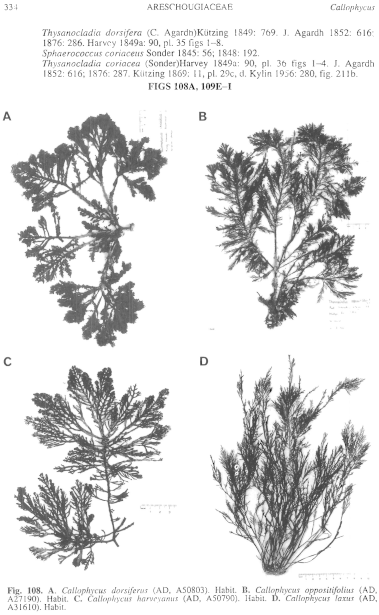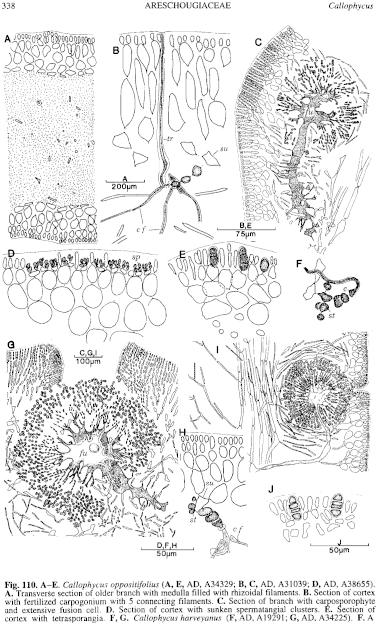|
|
|
|
|
|||||||||||
|
Electronic Flora of South Australia Species Fact Sheet
Phylum Rhodophyta – Class Florideophyceae – Order Gigartinales – Family Areschougiaceae
Selected citations: Min-Thein & Womersley 1976: 31, figs 11, 12, 53.
Synonym
Thysanocladia laxa Sonder 1853: 689.
Thallus (Fig. 108D) dark red-brown, 10–30 cm high, with linear, compressed axes 1–1.5 mm broad, complanately branched, with distichous, compressed, subopposite and entire pinnae 0.5–1.5 mm broad and 1–4 (–6) cm long, 0.5–2 cm apart on the axes, with a slight midrib, often developing into longer branches; older pinnae usually lost. Holdfast discoid to crustose, 1–3 cm across, with numerous erect axes; epilithic. Structure multiaxial, with medulla of entangled filaments and rhizoids and a pseudoparenchymatous cortex 3–5 cells thick, inner cells ovoid, 15–30 µm in diameter, and outer cells 3–5 µm in diameter. Rhodoplasts discoid to ribbon shaped, several per cell.
Reproduction: Sexual reproduction non-procarpic. Carpogonial branches (Fig. 110H) 3-celled, projecting laterally from an inner cortical cell with a reflexed trichogyne, with sterile cells on the supporting cell. Connecting filaments 4–7, unbranched and non-septate. Auxiliary cell and adjacent cortical cells becoming darker staining after diploidization and producing branches of small cells; fusion cell (Fig. 110I) producing radial gonimoblast filaments with terminal chains of subspherical carposporangia 7–10 µm in diameter, and with the axial filament enlarging. Cystocarps along simple or branched pinnae, often adjacent, sunk within the that/us, with moderate filamentous enveloping tissue, ostiolate. Spermatangia unknown.
Tetrasporangia (Fig. 110J) near pinnule ends, sparsely scattered in the outer cortex, basally attached, ovoid, 16–20 µm long and 10–12 µm in diameter, zonately divided.
Type from Rivoli Bay, S. Aust.; lectotype in MEL, 44495.
Selected specimens: West Bay, Kangaroo I., S. Aust., drift (Womersley, 6.i.1946; AD, A3206). Pennington Bay, Kangaroo I., S. Aust., 1–2 m deep on outer reef edge (Kraft, 13.iv.1973; AD, A43580). Lands End, West I., S. Aust., 16–19 m deep (Shepherd, 2.i.1967; AD, A31610). Horseshoe Bay, Port Elliot, S. Aust., drift (Min-Thein, 13.v.1971; AD, A38565). Robe, S. Aust., drift (Womersley, 29.viii.1949; AD, A10928). Stinky Bay, Nora Creina, S. Aust., drift (Womersley, 3.ix.1971; AD, A39562). Lady Julia Percy I., Vic., 19 m deep (Shepherd, 4.i.1968; AD, A32460). Cape Woolamai, Vie., 16 m deep (AIMS-NCI, Q66C 3481-Y, 16.ii.1990; AD, A60387). Wilsons Prom., Vic. (Mueller; MEL, 44510). Gordon, S Tas., 10 m deep (Blackman, 28.ii.1979; AD, A58495).
Distribution: West Bay, Kangaroo I., S. Aust., to Wilsons Prom., Vic.
Taxonomic notes: Records of C. laxus from N.S.W. and tropical Australia have been shown to apply to C. tridentifer by Kraft (1984b, p. 65).
C. laxus is a slenderer plant than C. harveyanus and has numerous erect axes from the crustose holdfast, in contrast to the single stipe of the latter. It is also of eastern distribution in contrast to the western C. harveyanus.
References:
KRAFT, G.T. (1984b). Taxonomic and morphological studies of tropical and subtropical species of Callophycus (Solieriaceae, Rhodophyta). Phycologia 23, 53–71.
MIN-THEIN, U. & WOMERSLEY, H.B.S. (1976). Studies on southern Australian taxa of Solieriaceae, Rhabdoniaceae and Rhodophyllidaceae (Rhodophyta). Aust. J. Bot. 24, 1–166.
SILVA, P.C. (1957). Remarks on algal nomenclature. Taxon 6, 141–145.
SONDER, O.W. (1853). Plantae Muellerianae. Algae. Linnaea 25, 657–709.
The Marine Benthic Flora of Southern Australia Part IIIA complete list of references.
Publication:
Womersley, H.B.S. (14 January, 1994)
The Marine Benthic Flora of Southern Australia
Rhodophyta. Part IIIA, Bangiophyceae and Florideophyceae (to Gigartinales)
Reproduced with permission from The Marine Benthic Flora of Southern Australia Part IIIA 1994, by H.B.S. Womersley. Australian Biological Resources Study, Canberra. Copyright Commonwealth of Australia.
Illustrations in Womersley Part IIIA, 1994: FIGS 108D, 110 H–J.

Figure 108 enlarge
Fig. 108. A. Callophycus dorsiferus (AD, A50803). Habit. B. Callophycus oppositifolius (AD, A27190). Habit. C. Callophycus harveyanus (AD, A50790). Habit. D. Callophycus laxus (AD, A31610). Habit.

Figure 110 enlarge
Fig. 110. A–E. Callophycus oppositifolius (A, E, AD, A34329; B, C, AD, A31039; D, AD, A38655). A. Transverse section of older branch with medulla filled with rhizoidal filaments. B. Section of cortex with fertilized carpogonium with 5 connecting filaments. C. Section of branch with carposporophyte and extensive fusion cell. D. Section of cortex with sunken spermatangial clusters. E. Section of cortex with tetrasporangia. F, G. Callophycus harveyanus (F, AD, A19291; G, AD, A34225). F. A carpogonial branch with basal sterile cells. G. Section of branch with carposporophyte. H–J. Callophycus laxus (H, I, AD, A38565; J, AD, A10928). H. Section of cortex with fertilized carpogonium with connecting filaments and supporting cell with 3 sterile cells. I. Longitudinal section with a carposporophyte, fusion cell, chains of carposporangia, and lax filamentous enveloping tissue. J. Transverse section of cortex with tetrasporangia. [A–I after Min-Thein & Womersley 1976.]

|
Email Contact: State Herbarium of South Australia |

|